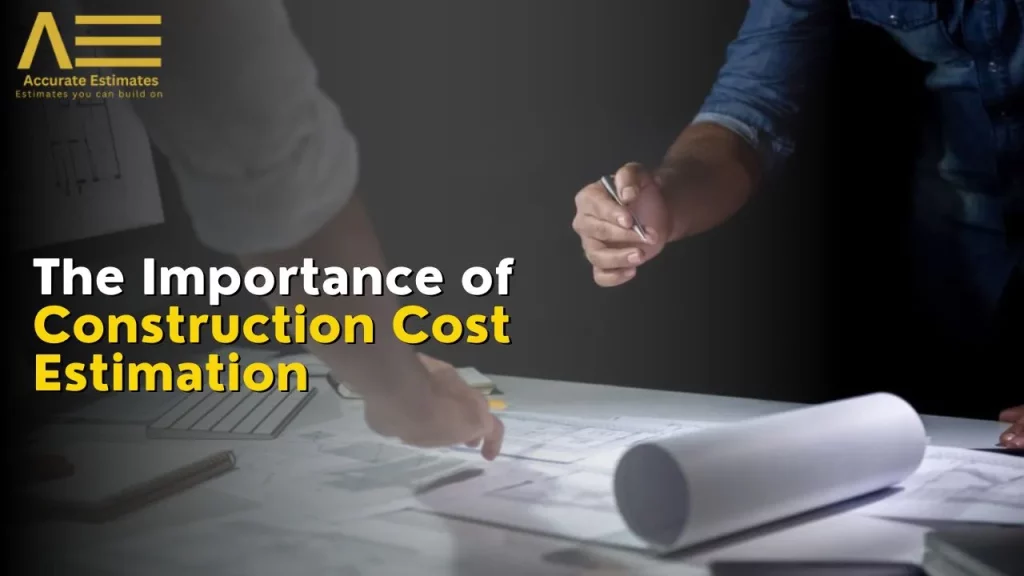Common Mistakes in Construction Estimating
Estimating a construction project’s cost is an important step that helps ensure its success. The process involves determining the initial expenditure, duration, and resources required to conclude the project. However, if you face this issue, you can talk with our experts at Accurate Estimates for final estimation and consultation.
Accurate calculation of your project is essential because it directly impacts the process of planning, budgeting, and overall success. Even experts with years of experience can make mistakes during this intricate procedure, resulting in substantial repercussions. We will explore common blunders in construction estimating and suggest some practical solutions to avoid them and pan accurately for a more successful project.
Why Construction Estimating Mistakes Happen?
When it comes to construction estimating, mistakes can occur for various reasons. One common cause is inaccurate or confusing plans and design specifications. When plans and specifications are unclear or contain errors, it can lead to inaccuracies in the estimate. Another potential source of error is inaccurate material takeoffs (MTOs), which form the basis for estimates. If the MTOs are incomplete or incorrect, it can result in mistakes in the estimation process.
Estimating labour costs
The experience level of workers and their corresponding productivity can impact the accuracy of cost estimates. Additionally, failing to stay updated on market conditions that affect material costs and regulations can lead to errors in estimations. Not conducting a site visit can result in oversight of crucial factors such as topography, climate, and environmental impact, which can affect the accuracy of estimates.
Misapplying risk and contingency factors
Without properly identifying the level of risk, you may apply the wrong contingency factor to an estimate. Ignoring risk assessments is another potential pitfall that can lead to accidents, delays, fines, and damage to a company’s reputation in the construction industry.
Furthermore, inaccurate estimates of construction material and supply costs because of price fluctuations can impact the overall accuracy of a project’s estimation. It’s crucial not to overlook reviewing subcontractor estimates. Delegating work to subcontractors requires thorough scrutiny of their estimates rather than blind trust. Additionally, miscalculating task dependencies is a common mistake that project managers make, leading to inaccuracies in the overall estimation of project timelines and costs.
Other reasons for construction estimating mistakes include the lack of a clear project scope definition, pressure to meet time constraints, and the temptation to appease clients with lower estimates. Other reasons include the absence of historical data, limited experience in cost estimation, lack of collaboration with stakeholders, and reliance on spreadsheets instead of specialized estimating software.
Impact of Estimating Mistakes on Projects
Inaccurate construction estimates can have far-reaching reactions on your project, it may affect the budget of your project. In inaccurate estimation, your cost may be higher and sometimes if it is cheaper it may lead to low-quality value or material usage.
- Cost Overruns and Budget Deviations: Underrating the project cost can lead to financial strain and reduced profitability for the construction company.
- Project Delays and Disruptions: Insufficient resources because of miscalculations may lead to project delays, impacting both the construction team and the client.
- Damage to Client Relationships and Reputation: Inaccurate estimates can erode trust between the construction company and its clients, potentially damaging its reputation.
How to Avoid These Mistakes
To ensure accurate construction estimating, you have to avoid these mistakes and also you can hire someone professional in estimation to accurately consider your project values. For more, you can hire our professionals to precisely estimate your project, and you will get a professional estimation report.
Conducting Thorough Site Inspections:
Comprehensive site visits provide valuable insights into potential challenges and allow for better planning.
Using Historical Data and Past Projects for Reference:
Historical data can be used to estimate similar projects correctly.
Involving Relevant Stakeholders in the Estimation Process:
Collaboration among construction estimators, managers, and domain experts ensures a more comprehensive assessment.
Employing Technology and Software for Accurate Calculations:
Construction estimating software can streamline the process and minimize human errors.
Best Practices for Construction Estimating
Adopt the following best practices to improve the accuracy of construction estimates:
- Breaking Down the Project into Smaller Tasks: Dividing the project into manageable components helps ensure everything is noticed during estimation.
- Seeking Input from Domain Experts: Consulting with specialists in various construction areas helps make more informed decisions.
- Regularly Updating and Revisiting the Estimates: Construction projects evolve, and estimations should be adjusted accordingly.
- Maintaining Clear and Detailed Documentation: Accurate documentation ensures transparency and serves as a point of reference throughout the project.
Importance of Continuous Learning
Staying updated with industry trends and regulations, attending workshops, and learning from past mistakes is essential for improving construction estimating continuously.
The Role of Communication
Establishing clear communication channels, encouraging open dialogue among team members, and addressing concerns promptly can significantly reduce estimation errors.
Real-Life Examples of Estimating Mistakes
Examining real-life construction projects with estimation errors provides valuable lessons and insights for improving future estimates.
The Long-Term Benefits of Accurate Estimating
We emphasize the significance of accurate construction estimating, such as increased profitability, improved project planning, and enhanced client satisfaction.
Conclusion
Accurate construction estimating is vital for the success of any construction project. By avoiding these typical mistakes and implementing best practices, construction companies can enhance their efficiency, profitability, and reputation within the industry.
FAQs
What is construction estimating?
The construction estimating procedure involves a few steps like the process of calculating the cost, time, and resources needed for a building project.
Why is construction estimating important?
The estimation is a very compulsory stage for your projects, as you need to identify your project’s estimated cost and time duration to complete. And you can do this by conducting thorough site inspections, involving domain experts, using historical data, and utilizing construction estimating software.
What are the consequences of underestimating project scope?
To understand any project scope, you need to have a clear idea of your budget and how to complete it within the time duration. To do this, you can use construction estimating software that can streamline the process, reduce errors, and provide quick and accurate calculations. Also, for more accurate results you may hire someone with professional experience in estimation like we have professional for this to be done nicely.
What are some common site-specific factors that may be overlooked?
Multiple factors are specific according to every site and most people overlook them. Accurate estimating ensures proper resource allocation, on-time delivery, and adherence to the budget, leading to successful project completion.




